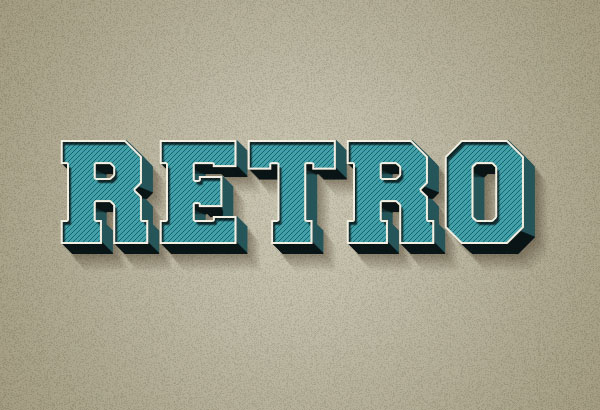3D Retro Text Effect

Step 1
Create a new 800 x 600px document, and duplicate the Background layer.
Step 2
Double-click the Background copy layer to apply a Gradient Overlay effect using the following values:- Check the Dither box
- Style: Radial
- Scale: 150%
- Create the Gradient using the colors
#c8c5b8to the left and#aaa593to the right.


2. Adding Subtle Noise to the Background
Step 1
Duplicate the styled Background copy layer, and then right-click the new copy and choose Rasterize Layer Style.If you're working with CS6 or earlier versions of Photoshop, you'll need to group the layer (Layer > Group Layers), and then merge the group (Layer > Merge Group) instead.
Set the Foreground color to
#c8c5b8 and the Background color to #aaa593.
Step 2
Go to Filter > Noise > Add Noise, change the Amount to 5 and the Distribution to Uniform, and check the Monochromatic box.
Step 3
Change the Background copy 2 layer's Blend Mode to Darken. This will add subtle noise to the background gradient.
Step 4
Click the Create new fill or adjustment layer icon at the bottom of the Layers panel and choose Levels.
Step 5
Change the Shadows value to 72, the Gamma to 1.05, and the Highlights to 236. This will adjust the coloring of the background.
3. Creating the Text and the 3D Extrusion
Step 1
Create the text in All Caps using the font Freshman Normal. The Size is 125 pt, the color is#43a0a8, and the Kerning is set to Optical.
Step 2
Duplicate the text layer and drag the copy layer below it.
Step 3
Enter the Free Transform Mode by going to Edit > Free Transform (Command-T). Tap the Right Arrow Key once, and then tap the Down Arrow Key once as well, to move the copy text one pixel to the right and one pixel downwards. Then hit the Return key to accept the changes.
Step 4
Press the Option-Command-Shift-T (Alt-Ctrl-Shift-T for Windows) ten times to duplicate the layer with the transformation to create the 3D extrusion.
4. Creating the Smart Objects for the 3D Extrusion and the Shadow
Step 1
Select all the copy text layers, and change the text color to#c7b299.
Step 2
With all the copy text layers still selected, go to Filter > Convert for Smart Filters. Rename the smart object's layer to 3D Extrusion, duplicate it, drag the copy below it, and rename the copy to Shadow.
5. Styling the Original Text Layer
Double-click the original text layer to apply the following layer style:Step 1
Add a Stroke with these settings:- Size: 2
- Position: Inside
- Color:
#f2eee1

Step 2
Add an Inner Shadow with these settings:- Color:
#464646 - Opacity: 100%
- Uncheck the Use Global Light box
- Angle: 129
- Distance: 5
- Spread: 50
- Size: 2

Step 3
Add a Pattern Overlay with these settings:- Blend Mode: Soft Light
- Pattern: Fine diagonal lines


6. Styling the 3D Extrusion
Double-click the 3D Extrusion layer to apply the following layer style:Step 1
Add a Bevel and Emboss with these settings:- Technique: Chisel Hard
- Size: 13
- Uncheck the Use Global Light box
- Angle: 82
- Altitude: 11
- Check the Anti-aliased box
- Highlight Mode - Opacity: 0%

Step 2
Add a Contour with these settings:- Check the Anti-aliased box.

Step 3
Add a Color Overlay with these settings:- Color:
#265559



7. Working on the Shadow
Step 1
Select the Shadow layer, then go to Filter > Blur > Motion Blur. Change the Angle to -55 and the Distance to 20. You need the Angle value to match the 3D extrusion's angle.
Step 2
Change the Shadow layer's Blend Mode to Multiply, and then use the Move Tool to drag the shadow and move it around until you like how it looks.
Step 3
Click the Create new fill or adjustment layer icon at the bottom of the Layers panel and choose Hue/Saturation.
Step 4
Click the Clip adjustment to layer icon at the bottom of the Properties panel, and change the Saturation value to -65.







0 komentar: